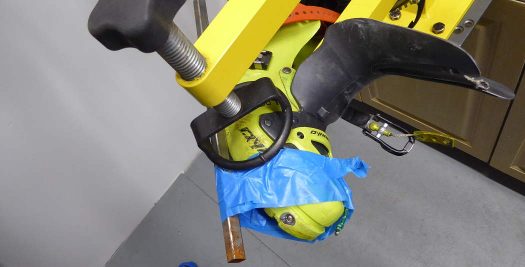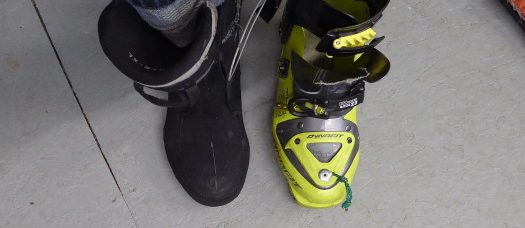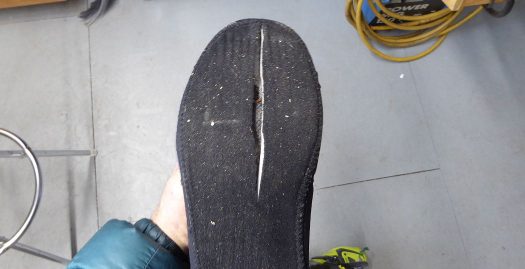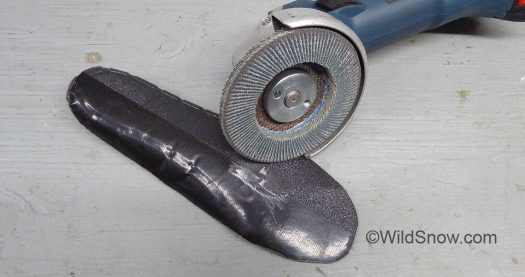
Punchomatic. I pre-heat the ring press mandrel (hidden inside boot), and using an infrared thermometer I keep the temperature of the Grilamid under 240 degrees. This kind of punch is best with Grilamid and PU plastics, Pebax is difficult. The chunk of steel under the ring places most of the ring pressure on the edge of the sole area so the punch doesn’t get blocked by the edges of the ring. Multiple punches are required.
A boot fitting client has Morton’s Neuroma. We think probably caused by too many years in pointy toe ski touring boots compressing their metatarsal bones like they’re skiing in a machinist’s vise. Whatever the cause, this is serious. Morton’s can shut down a ski touring career, not to mention placing you in a desk chair the rest of your life.
(Morton’s is a thickening of tissue around a nerve that routes between metatarsal bones in the ball of your foot. It feels like you’ve got a rock in your boot, and it hurts. Problem: if unchecked Morton’s feeds on itself and gets progressively worse. Morton’s Neuroma.
Morton’s treatment general outline, in order of priority:
– Modify footwear (including footpads adhered to feet, boot widening, and footbed mods).
– Anti inflammatory measures (NSAID and ice).
– Physical therapy (stretching and massage).
– Lifestyle adjustments (quit working on concrete floors, or ski less?).
– Injections and other medical provider interventions.
– Surgery.
This blog post: how we modify ski boots for the condition.

First step was to do a mega-punch on the TLT-6 toebox. Widest part of foot was located on both sides. Punching began there and was extended forward and back. I’m not sure how much the widening process is shown in this photo, but we enlarged the last by around 7 millimeters along with customizing to the shape of the foot. The boot now fits with virtually no squeeze on the metatarsal, quite comfortable though downhill performance is slightly compromised. You can see the customized shape at the toe of the liner.

Gill cuts were made before a liner remold. I make the slits in the bottom, top and sides of the metatarsal area. After final fitting, the cuts are taped over while the foot is in the liner with an extra sock, so the cuts stay spread out under the tape.

Last thing for now. Locate neuroma by palpating with fingers under footbed while it’s held on the bottom of foot. Mark location, then do a bit of grinding to form a pressure reduction pocket. This is done with care, in stages. Most footbeds are quite hard, it may be necessary to swap in a gel footbed (cheap ones available at pharmacy can be very effective). It may also be advisable to use a wider footbed. Check that your molding and modding does not create a “boat” shaped footbed that compresses the foot. The “mets” need to spread out.
Experimentation is key with this. Morton’s is pain, so it’s easy to test different fits until something provides relief. While doing so, it’s best for the boot fitting client to go off their NSAID pain killers so their feet are sensitive to footwear customization. This is especially helpful when you palpate under the footbed with their foot on top, to located the exact point you skive under the footbed.
Once the boot and footbed are modified, it’s time to pursue cortisone and perhaps more if the problem continues. Modifying all other footwear is also recommended.
WildSnow.com publisher emeritus and founder Lou (Louis Dawson) has a 50+ years career in climbing, backcountry skiing and ski mountaineering. He was the first person in history to ski down all 54 Colorado 14,000-foot peaks, has authored numerous books about about backcountry skiing, and has skied from the summit of Denali in Alaska, North America’s highest mountain.
